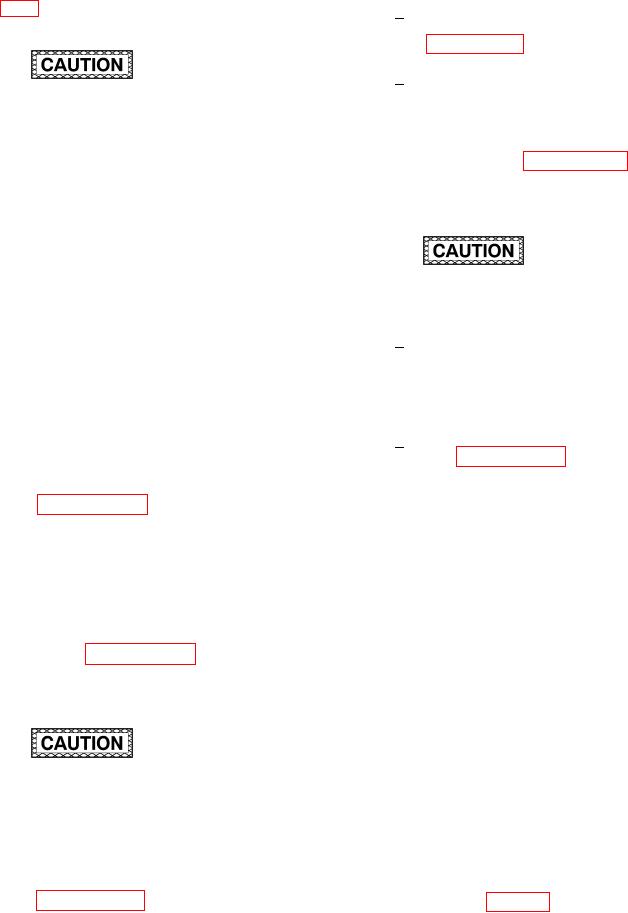
TM 1-1500-204-23-11
6-18e and the system speciic technical
Visually inspect adhesive squeeze
1
manual.
out at patch edge as described in
paragraph 5-2. See 6-45.
Perform NDI of patch to skin and
2
patch to iller bond areas to verify
Reduced strength will result if the incorrect
bondline integrity.
mix ratio is used, if an excessive amount
of air is introduced into the adhesive during
(m) If applicable, repair the outer lightning
mixing, or if mixing is inadequate and may
mesh according to paragraph 7-12 and
result in loss of structural integrity.
the system speciic technical manual.
Pressure must be applied to adhesive within
(n) Reinish.
the pot life of the resin. For ambient temper-
atures in excess of 90 F, decrease this time
by 50%. An unsatisfactory repair will result
if the resin gels before adequate pressure is
applied and may result in loss of structural
DO NOT sand into laminate near patch edge
integrity. Select and prepare a heat blanket
when sanding adhesive squeeze out.
(if required) and all necessary vacuum bag
materials prior to mixing resin.
Sand the area smooth with 180 grit
1
abrasive paper. Vacuum sanding
Failure to observe the correct number of repair
dust from repair area. Wipe with
plies, the correct repair ply orientation, the
clean, dry wiping cloth to remove
correct repair ply overlap and removal of all
sanding residue.
pieces of vacuum bagging ilm will reduce the
strength of the repair and may result in the
Apply inish system in accordance
2
loss of structural integrity.
with paragraph 7-13b or the system
speciic technical manual.
(i)
Prepare the repair plies in accordance
with paragraph 6-16, Wet Layup, and
b. Full Thickness Scab Repair. Scab repairs are
place stacked, oriented patch on the
similar to scarf repairs but easier to complete since
damaged site. Refer to the system spe-
they do not require machining the scarf. Filler plies
ciic technical manual for the repair iber,
are used in the damaged area and the patch is
resin, number of plies, ply orientation,
applied to the surface. Exterior scab repairs are used
ply size and overlap.
when the protrusion of the patch does not impact the
aerodynamics on the surface of the structure. They
(j)
Determine and apply cure hardware
may be used when an adhesively bonded metallic
and vacuum bagging materials in accor-
or pre-cured composite patch cannot be used due to
dance with paragraph 6-18. Refer to
excessive part curvature. The size of the repair area
the system speciic technical manual for
depends on the thickness and number of plies of
the porous release ilm, bleeder mate-
the skin and the required overlap. Thicker structures
rial and the number of bleeder plies.
require larger patches relative to the original damage
area. Ply overlap is determined according to the
loads that must be transferred. The ply overlap
for any repair in a given weapon system will be
called out in the system speciic technical manual
Failure to properly cure adhesive in accor-
or other authorizing document. Refer to the system
dance with the speciied cure cycle will result in
speciic technical manual for applicable damage limits.
reduced repair strength may not be detectable
Scab repairs can be used on all glass, carbon, and
by visual or nondestructive inspection. This
aramid composite materials. This repair procedure
may result in loss of structural integrity.
is not necessarily applicable to a particular weapon
system. The applicability of this repair depends upon
(k) Cure the repair patch in accordance
additional factors such as loading conditions and
with paragraph 6-19, Curing Advanced
laminate thickness. Refer to igure 7-7 for the Process
Composites.
Flow Diagram for Penetration Damage Repair. Consult
the system speciic technical manual or engineering
(l)
NDI Patch Bond(s).
for further guidance.
7-15

